Monarchs are some of the most popular butterflies in the world. Contrasting dark orange and black coloring make the species stand out.
These butterflies are also highly popular for their capacity to migrate over long distances. Monarch butterflies in North America can migrate over distances of more than 2.000 miles.
Monarch butterflies are sometimes seen on milkweed when they migrate. Milkweed is used as a stepping stone or resting and feeding location for their long journeys.
While unique in habits, Monarch butterflies are sometimes confused with other species that look quite similar.
Table of Contents
What do Monarch butterflies look like?

Monarch butterflies are dominated by black and orange coloring. They have wide black wing margins and black veins.
The orange coloring of these butterflies tends to be of a darker nuance.
White dots or marks are also visible on the margins of these butterflies.
Appearance differences are also common among males and females. The male Monarch butterfly has 2 black spots on its wings.
Some species that resemble Monarch butterflies can be differentiated by aspect and even range.
Monarch butterflies in the Western parts of North America migrate Southwards to California to overwinter. Eastern Monarch butterflies in North America migrate further to Mexico to overwinter.

Butterflies That Look Like Monarchs
The following species of butterflies can resemble Monarchs in appearance and habits.
1. Queen butterfly
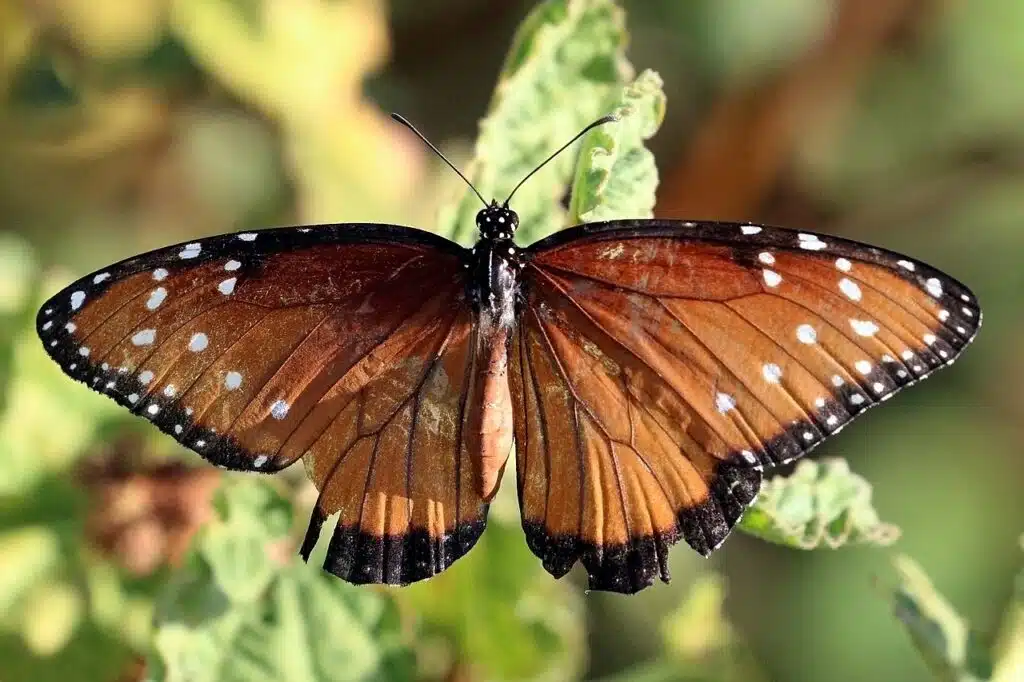
Part of the Danaus genus (the same as Monarch) Queen butterflies (Danaus gilippus) is highly similar to Monarchs.
You can differentiate these butterflies from Monarchs by the lack of black vertical stripes on their wings.
These butterflies have a base orange, red-brown, or dark brown color. Wide black wing margins are further visible on the species.
Queen butterflies live in somewhat similar habitats to Monarchs. They like tropical and temperate climates and are common in North America.
Unlike the various sub-species of Monarchs, Queen butterflies don’t migrate or only migrate over very short distances.
Queen butterflies can be seen on various plants eating nectar. They also consume fruit and dung.
Seen in meadows, open fields, and even deserts, this species has a generalist feeding habit with a mild preference for milkweed.
2. Viceroy

Viceroy butterflies (Limenitis archippus) are known for having a high resemblance to Monarchs which they mimic. In turn, Monarchs also mimic Viceroy butterflies in a process known as Müllerian mimicry.
This type of mimicry is common in species that overlap each other as Viceroy, Monarch, and Queen butterflies share the same environment.
Viceroy butterflies have similar but still different coloring to Monarchs in the regions they live together.
Monarchs are highly present in Northern US parts where Viceroys have a lighter color.
Viceroys have a lighter color in Florida, an area they try to differentiate themselves from Queen butterflies which are more numerous.
Apart from not migrating, Viceroy butterflies can also be differentiated from Monarchs by food preferences.
These butterflies feed on willow and poplar as caterpillars.
Viceroy adult butterflies only feed on plant nectar with a preference for milkweed and thistles.
3. Soldier butterfly
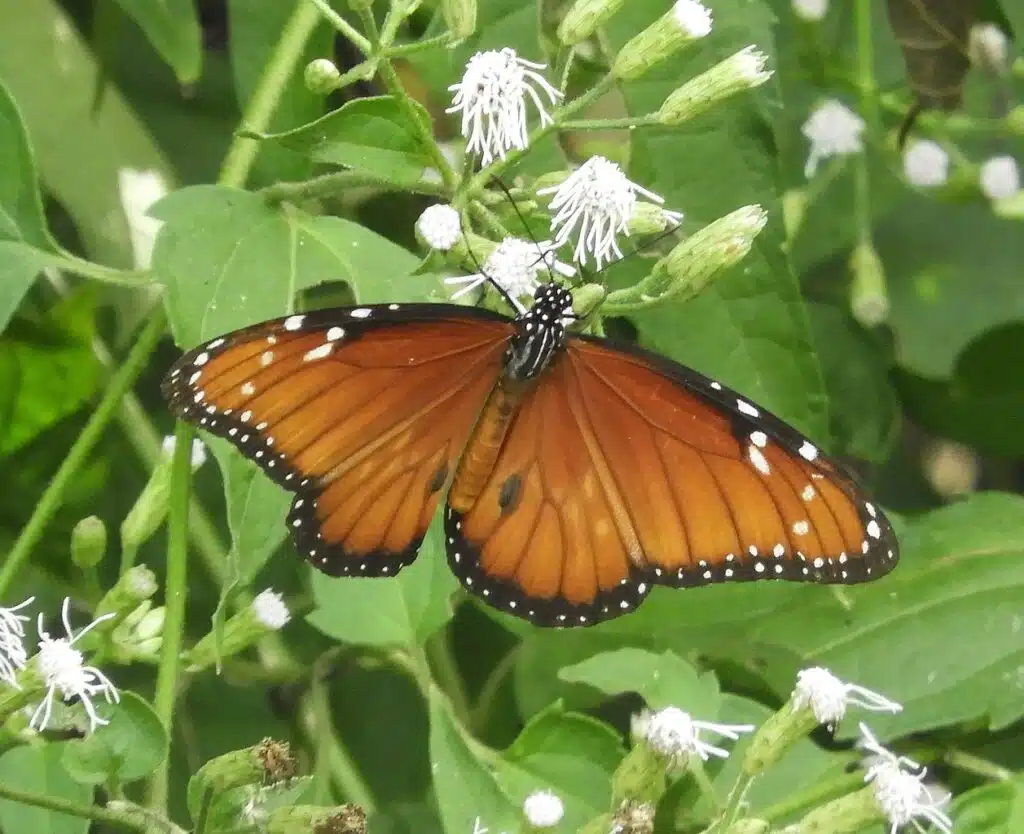
Solider butterflies (Danaus eresimus) bear resembles Monarchs and Queen butterflies. They are only found in Florida and Southern Texas.
You can differentiate Soldier butterflies from Monarchs by a darker coloring, narrower black stripes, and white patches across the wings.
Solider butterflies have a darker color that appears brown at times as opposed to the nuance closer to pure orange of Monarchs.
Solider butterflies have thin black stripes on the wings which further differentiates them from Monarch and Queen butterflies.
These butterflies also have multiple white patches on the upperside of the wings.
Smaller differences between Solider and Monarch butterflies include the overall gradient color of the species.
Solider butterflies have a darker color on the upper wings and a lighter color on the lower wings.
4. Gulf Fritillary

Gulf Fritillary butterflies (Dione vanillae) have orange and black coloring which makes them resemble Monarchs.
These butterflies are highly common around woodlands and grasslands in Florida with a species also being present in Texas.
Butterflies of this genus are known for migrating over shorter distances compared to Monarchs. However, this migration sometimes confuses the species.
Gulf Fritillary butterflies only migrate within Florida.
They begin migrating to Northern parts of the state to then make their way back to Southern Florida.
Butterflies of this genus feed on lantana flowers as adults and passion vines as caterpillars.
Further differentiation between the species can be seen in their coloring.
The underside of the wings of Gulf Fritillary has white marks.
This species is also found outside the US. Central and South America have high Gulf Fritillary populations.
5. Pearl Crescent

Pearl Crescent butterflies (Phyciodes tharos) have similar orange and black colors to Monarchs. These butterflies are considerably smaller and differently patterned.
Pearl Crescents grow to a maximum wingspan of 34mm while Monarchs have a wingspan between 3 and 4 inches.
Found in open areas, these butterflies feed on a wide range of flowers. They feed on nectar from dogbane and thistles.
The black pattern on the orange wings is what differentiates Pearl Crescent from Monarchs further.
The wings of the species also show horizontal lines apart from black vertical stripes.
Pearl Crescents are only seen in the extreme South of the US and parts of Mexico.
6. Painted Lady

The Painted Lady (Vanessa cardui) is one of the most common species with a migratory nature that resembles Monarch butterflies.
A few different body patterns separate the species from Monarch. Pained Lady butterflies have orange coloring with brown and black irregular patterns on the wings.
White spots along the wings further differentiate this species from Monarchs.
Painted Lady butterflies are a widespread species that live in North America, South America, Europe, Africa, Asia, and Australia.
These butterflies are subject to one of the major migratory processes in the world of butterflies moving between Africa and Europe with the seasons.
This colorful species is known for being bred in captivity. Otherwise, it can sometimes be seen on asters in their caterpillar stage.
7. American Lady

American Lady butterflies (Vanessa virginiensis) also have a considerable worldwide presence.
Butterflies of this genus resemble Monarchs in color and black margins along the wings.
The species lacks the vertical stripes specific to adult Monarchs but has wide black margins on a base orange color.
White dots are seen on the upper side of the wings.
Larger color and pattern differences are seen on the ventral side of the species.
American Lady butterflies have gray eyespots on the underwings. Red-orange diagonal lines on the upper side of the wings are also visible in this species.
American Lady caterpillars are mostly brown. They have off-white stripes across the body and long bristle-like black hairs.
8. Red Admiral

Red Admirals (Vanessa atalanta) are black with red bands and white spots.
These large butterflies are seen in multiple parts of the world, particularly in temperate climates. As Monarchs, Red Admirals travel long distances migrating South from their temperate climates.
Red Admirals can be seen around various species of nettle including stinging nettle.
Adult Red Admirals are mostly fond of the nectar of multiple nettles but they can also consume overripe fruits.
The migration of Red Admirals is determined by the abundance of stinging nettle. Red Admirals are specifically looking for vast meadows and open areas with stinging nettle.
Mating is a complex process in Red Admirals. Males are aggressive and territorial while females only choose to mate with the most territorial males.
9. Variegated Fritillary
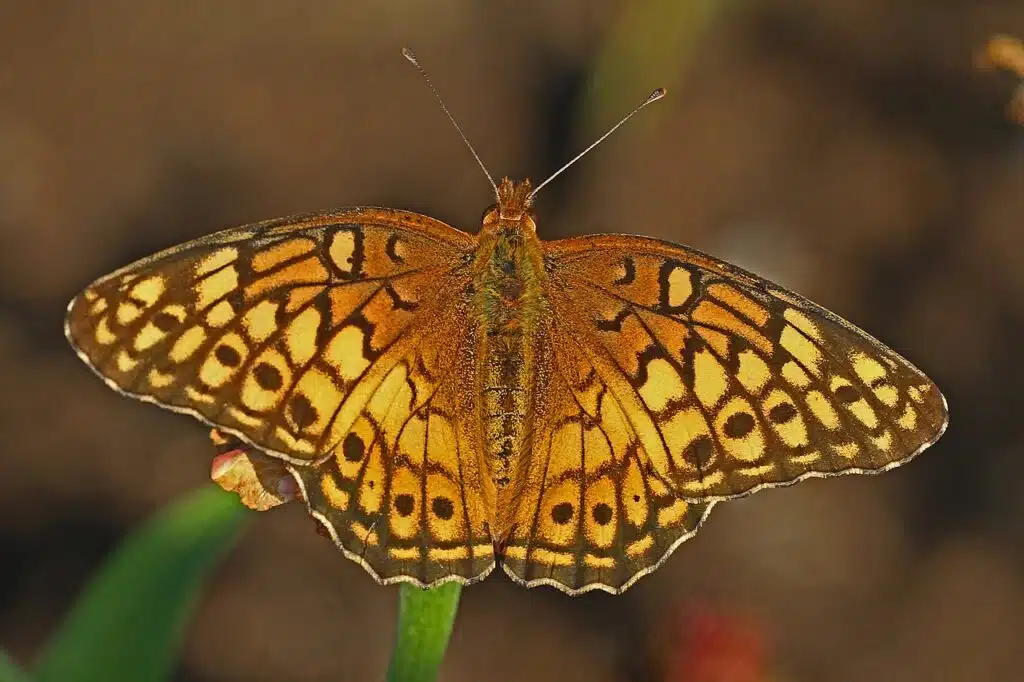
The Variegated Fritillary (Euptoieta claudia) is a common species that are similar to Monarchs.
It has light orange and dark orange coloring and black colors in a checkered pattern.
There are no thick black margins on the Variegated Fritillary as on Monarch butterflies.
Butterflies of the species are common on passionflowers. They are known to seek out passionflowers over their short nomadic adventures.
These butterflies aren’t easy to spot as they fly away whenever they see people.
Variegated Fritillary is the butterfly seen in open areas, sometimes on crops.
The species is commonly seen on alfalfa and clover fields.
10. Great Spangled Fritillary

Similar to Monarchs, Great Spangled Fritillary butterflies (Speyeria cybele) are also dominated by orange and black colors.
These butterflies have a gradient orange color that’s almost brown on the upper side of the wings and bright orange on the lower side.
The wings have checkered black patterns and black antennae.
Females of the species have lighter orange-yellow coloring which makes them easy to differentiate from males.
11. Silvery Checkerspot

The Silvery Checkerspot (Chlosyne nycteis) is a common species that feed on milkweed and clovers, similar to Monarch and other species that resemble Monarch butterflies.
Silvery Checkerspot has a yellow-orange color with black margins and black veins across the wings.
Submarginal white spots are also seen on the species.
Silvery Checkerspot butterflies are present in most US territories South of Canada.
However, unlike the Eastern Monarch subspecies, the Silvery Checkerspot is not present in the Gulf of Mexico.
Its absence in these regions is not singular.
The Silvery Checkerspot is a species that’s facing a diminishing habitat in multiple states including New Hampshire.
Silvery Checkerspot butterflies haven’t been seen for years in a few other Northeastern states as well.
12. Phaon Crescent

Phaon Crescent butterflies (Phyciodes phaon) are seen on turkey tangle frog fruit.
These butterflies can sometimes be confused with migrating Monarchs in Florida since they’re only present in Florida and not in the other US States.
Phaon Crescent butterflies are a common sight in neighboring island states such as Cuba as well.
You can identify the species by its black and orange dorsal colors.
Multiple pale white spots are also visible on the upper side of its wings.
The Phaon Crescent butterfly is among the checkered butterflies that also resemble Queen butterflies.
Brighter underside coloring helps distinguish this species from other similar butterflies.
These butterflies are also known not to migrate as Monarchs that come to Florida from the North.
13. Bordered Patch

Bordered Patch butterflies (Chlosyne lacinia) get their name from their dark colors with bright patches on them.
Black is the dominant color in these butterflies. White and yellow bands and patches are also specific on the outer side of the wings. Butterflies of this family only have 2 small orange spots.
Assessing the dominant dorsal color is the easiest way to differentiate Bordered Patch butterflies from Monarch butterflies which are dominantly orange.
These butterflies are among the most common species that live in Texas and Arizona. The common Texas blueweed is one of the host plants of the species.
Bordered Patch butterfly populations in Texas also don’t migrate.
The species remains in one place throughout the year. Furthermore, spotting the species might be easier as the caterpillars of the Bordered Patch butterflies grow and feed together in groups.
Up to 4 broods per year can be seen of this species, particularly in Texas (not Arizona) where these butterflies remain active all year.
14. California Tortoiseshell

California Tortoiseshell butterflies (Nymphalis californica) live in Western parts of the United States and Mexico in high numbers.
The species is neither a common migrator nor a sedentary species as it chooses to migrate on occasion to other states.
California Tortoiseshells are sometimes seen as far as Michigan or Ohio where they can be occasional migrators.
These butterflies are seen in chaparral and woodlands along open areas next to forests.
Physical resemblance to Monarchs is tied to the orange and black colors of these butterflies.
Orange dominates the aspect of the dorsal of these butterflies. Black dots and black margins are seen on the wings, but not to the extent seen on Monarch butterflies.
The margins of the wings can also be gray which means there’s less of a contrast between the margins of the wings Monarchs have with the gray margins California Tortoiseshell butterflies have.
15. Mylitta Crescent

Also having a vivid color similar to Monarchs, Mylitta Crescent (Phyciodes mylitta) are native species in the Western United States where they live in high numbers.
These butterflies are also native to Mexico.
Orange coloring dominates the wings and the body of the species. Checkered black wings make it look more similar to Monarch butterflies than to other species.
Adults feed on plant nectar and caterpillars are seen feeding on milk thistle.
Unlike other butterflies in the Western US, Mylitta Crescents are highly adaptable according to where milk thistle grows.
It means the species live in lowlands but it can also live at high altitudes of up to a few thousand feet.
16. Northern Crescent
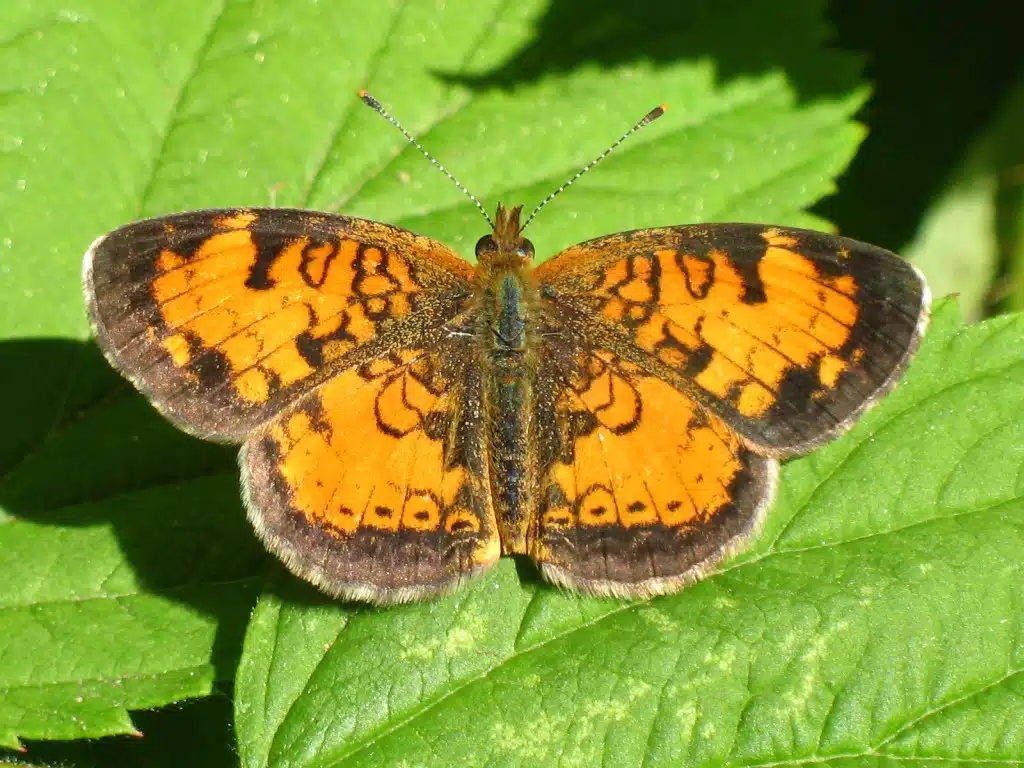
Northern Crescent (Phyciodes cocyta) has a widespread presence in the North.
They are common in very high numbers in the area of The Great Lakes as well as other habitats to New England in the North East.
They are also common across a few other states down to Texas.
Orange and black dorsal coloring makes this species similar to Monarch butterflies.
You can identify the species by its orange background dorsal color and black checkered marks all across the wings.
The specie has thin white margins as well as alternating black and white bands on its long antennae.
The caterpillar of the Northern Crescent is seen on asters, a wide range of wildflowers across North America.
Adults feed on plant nectar. However, these butterflies don’t feed on the same plants as Monarchs which helps differentiate the species.
Adult Northern Crescent feeds on dogbane nectar as well as on fleabane nectar.
The species remains smaller than Monarch butterflies even with food abundance as its wings might measure up to 1.7 inches in wingspan.
17. West Coast Lady
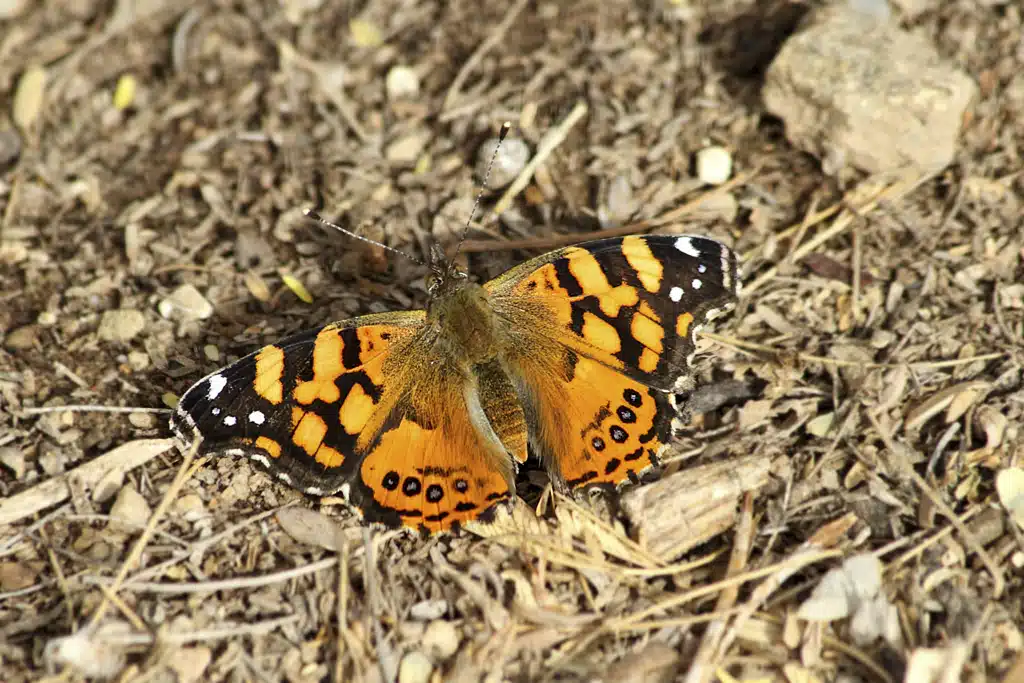
Larger than Northern Crescents but smaller than Monarchs, West Coast Ladies (Vanessa annabella) are a common sight all across the Western Coast US territories and Countries of Central America such as Mexico and Guatemala.
This species has orange and black dorsal coloring but it’s only the upper side of the wings that resembles the pattern of Monarch butterflies.
Orange background color with black margins and black stripes are seen on the upper side of the wings of West Coast Lady butterflies.
The lower side of the wings is without stripes. Black dots or gray dots with black margins decorate the dorsal side of the wings of the West Coast Lady, unlike the continuous stripes seen on the wings of Monarchs.
The West Coast Lady is among the species that also feed on the nectar of various plants.
However, its caterpillars look different and are seen on different hosts compared to Monarch caterpillars.
West Coast Lady caterpillars feed on mallow family leaves and have an almost uniform gray color.
18. Meadow Fritillary

The Meadow Fritillary butterfly (Boloria bellona) is sometimes confused with Monarch butterflies living in the North.
However, Meadow Fritillary butterflies are highly common in Canada and to a lesser extent, in the Northern parts of the US.
These butterflies move South to escape the cold months in Canada.
A checkered orange and black pattern are specific to the dorsal of the species.
As in Monarch butterflies, Meadow Fritillary butterflies have an orange-dominating color. They also have black checkered patterns but no black stripes or wide black margins such as Monarch butterflies.
This species can be seen in open fields, next to streams, or around swamps, but not in forests.
Those having trouble differentiating Meadow Fritillary butterflies from Monarch butterflies can further compare the wingspan of these species.
The Meadow Fritillary butterfly is 2 to 3 times smaller than Monarch butterflies.
19. Behr’s Metalmark
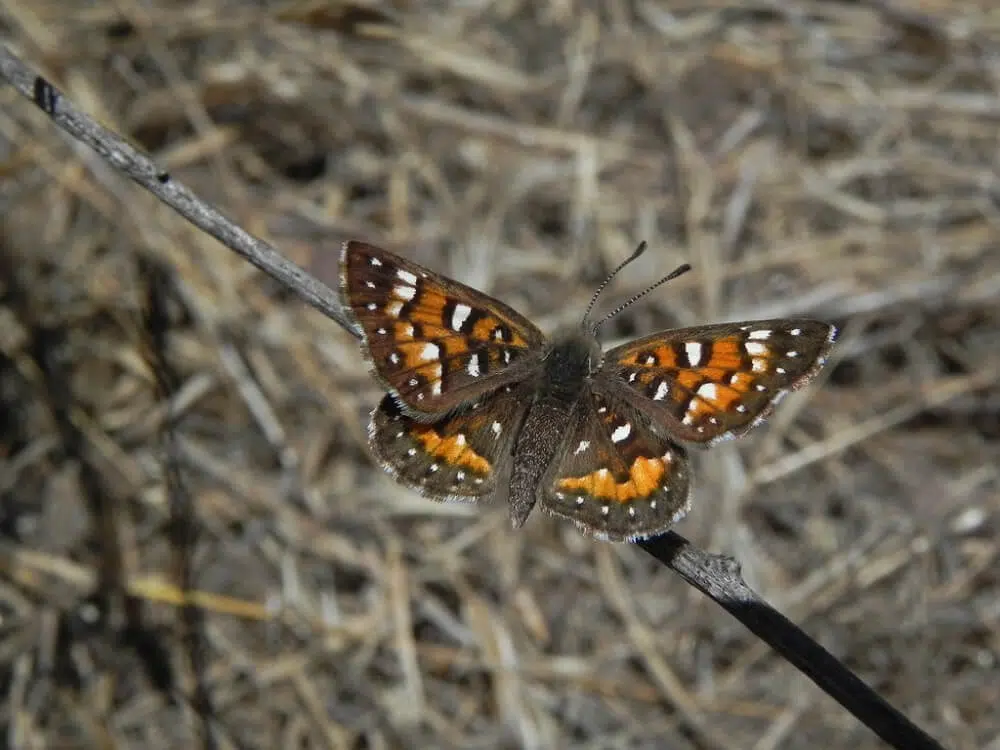
Behr’s Metalmark butterflies (Apodemia virgulti) are slightly similar to Monarch butterflies.
One of the easiest methods to establish a correct species when comparing these butterflies is to assess the range.
Both Monarch and Behr’s Metalmark are seen in California.
Monarch butterflies migrate to California from Northwestern territories while Behr’s Metalmark butterflies only live in California (and parts of Baja California).
These butterflies have black, orange, and white coloring but orange is only seen on a small section of the wings unlike on Monarchs.
These butterflies are mostly black and gray with orange sections and white dots all across the wings.
The body of Behr’s Metalmark butterfly is mostly gray and black.
Butterflies of this species are mostly dark-colored and not as contrasting as Monarch butterflies.
The species feed on Eriogonum.
20. Northern Checkerspot

Northern Checkerspot butterflies (Chlosyne palla) live in Western parts of the US.
This species has similar coloring to Monarch butterflies. It has orange and brown colors with a black body.
Monarch butterflies have different coloring which is a combination of orange and black rather than orange and brown.
Northern Checkerspot caterpillars can be seen together on goldenrod.
Rabbitbrush is also a common host plant of the caterpillars.
Further differences between the aspect of the caterpillar Northern Checkerspot and the Monarch caterpillar exist in terms of color.
Northern Checkerspot caterpillars are all-black while Monarch caterpillars have black, yellow, and white bands across the body.
21. Atlantis Fritillary

Atlantis Fritillary butterflies (Speyeria atlantis) are known for their orange and black color combination on the dorsal side and orange-brown and white color combination on the ventral side.
These butterflies are mostly orange. They have orange wings with checkered black patterns and black margins.
The margins of the species are not as wide as the margins of the Monarch butterfly.
Both Monarchs and Atlantis Fritillary eat plant nectar, which may make some people confuse the species.
Milkweed is a common type of nectar source for monarchs and butterflies that look like Monarchs.
However, Atlantis Fritillary also consumes laurel and spirea flower nectar.
22. Milbert’s Tortoiseshell

Milbert’s Tortoiseshell butterflies (Aglais milberti) are among the common species of North America. These butterflies are found in vast Canadian and US territories.
The butterflies are found South of Alaska and in many US territories, especially across Eastern states.
This species has a dark brown to black dorsal coloring which makes it a dark-color butterfly.
The edges of the wings are dominated by orange and yellow bands. Smaller orange spots are also seen on the dorsal area of the species.
Butterflies of this genus also have small white spots across the margins of the wings.
Apart from its dark color, Milbert’s Tortoiseshell butterflies also have slightly different habitat preferences compared to Monarchs.
These butterflies live in moist areas and they breed in moist areas such as habitats near streams and rivers.
23. Vesta Crescent

Vesta Crescent butterflies (Phyciodes graphica) have an orange-dominated dorsal. A checkered black pattern is also visible on its wings which makes it similar to Monarch butterflies.
The species is common in New Mexico and Texas. This species also lives in Mexico.
Unlike Monarch caterpillars, the species has mostly dark-colored wings as the orange sections are reduced compared to the bright large orange dorsal sections of Monarch butterflies.
You can further differentiate Vesta Crescent butterflies from Monarch butterflies by the host species of the caterpillar.
Vesta Crescent caterpillars are seen on hairy tube-tongue.
Adults move on to woodlands and desert areas specific to the extreme South of the US as well as to parts of The Gulf of Mexico.
Both Vesta Crescent and Monarch caterpillars continue feeding on various types of flower nectar into adulthood.
24. Mormon
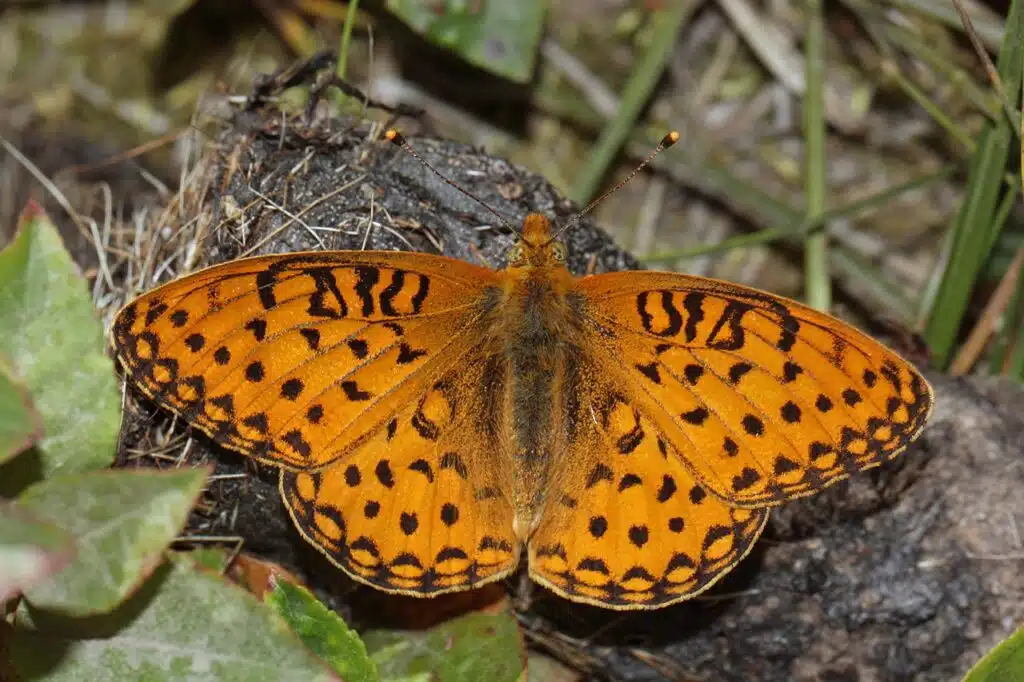
Mormon Fritillary butterflies Fritillary (Speyeria mormonia) are common species seen across multiple states. These butterflies bear a high physical resemblance to Monarch butterflies.
Mormon Fritillary butterflies are also orange. The nuance of orange is closer to brown and not as bright as the orange of Monarch butterflies.
The wings are decorated with a black checkered pattern that also exhibits small white markings on the margins of the wings.
These butterflies have a black body which makes the species appear different from other butterflies that look like Monarchs.
Further differences can be made in the host plants of many butterflies that resemble Monarchs in the US.
Violets are among the preferred host plants of Mormon Fritillary.
25. Callippe Fritillary
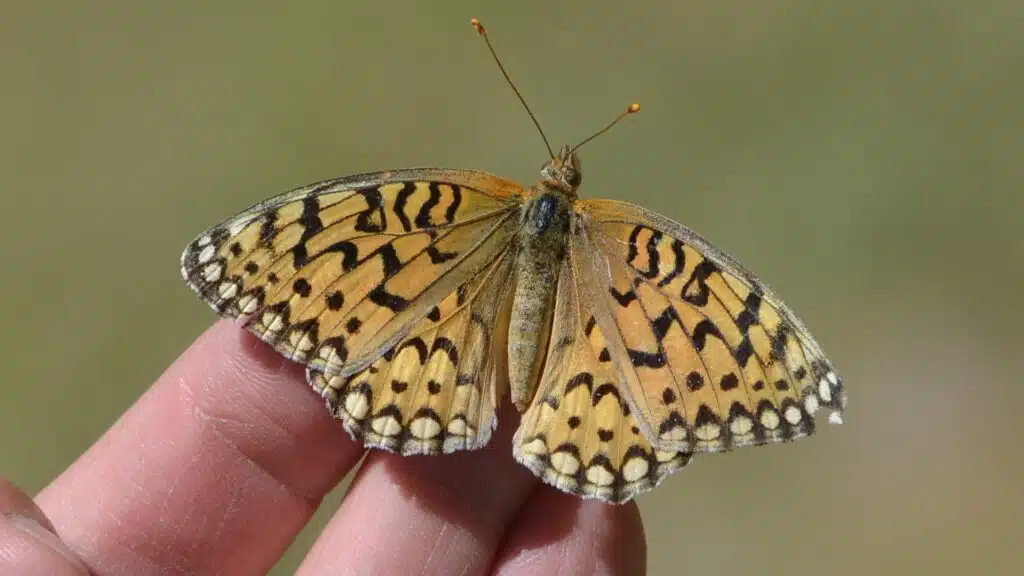
Callippe Fritillary butterflies (Speyeria callippe) have a high resemblance to Mormon Fritillary and Monarch butterflies.
The species has orange and black dorsal coloring in the case of males and orange, white, and black coloring in the case of females.
White dots are seen across the dorsal wings of the female.
The checkered black patterns on the wings differentiate the Callippe Fritillary butterflies from Monarch butterflies.
The species is common in Northwestern US territories and the extreme South of Canada’s British Colombia.
These butterflies have multiple broods per year.
Females lay eggs near or on violet flowers. These eggs overwinter and then emerge as the first brood feeding on violet flower leaves.
These butterflies are always seen in dry habitats such as woodlands and prairies.
26. Gorgone Checkerspot

These butterflies (Chlosyne gorgone) also bear resemblance to Monarchs, even if they have a shorter wingspan.
Gorgone Checkerspot butterflies only measure up to 1.3 inches in wingspan and can be a few times smaller than Monarch butterflies.
Orange and black colors dominate the dorsal colors of the species.
Black vertical stripes and horizontal lines, as well as black margins, are specific to this species.
The habitat is somewhat similar although Gorgone Checkerspot butterflies aren’t present on the Eastern Coast or the Western Coast of the US.
You can find Gorgone Checkerspot butterflies on all types of meadows but also on crops.
These butterflies highly favor sunflower crops to lay eggs.
Adults maintain some of these preferences from their caterpillar stage as they only eat nectar from yellow flowers that resemble sunflowers.
27. Silver-bordered Fritillary

Silver-bordered Fritillary butterflies (Boloria selene) are a common species across Northern US and Southern Canada with a reduced presence on the Western sides of the continent.
Butterflies of this genus feed on goldenrods and do not prefer milk thistle.
Further differences between Silver-bordered Fritillary butterflies and Monarchs can be seen in the habitat of the species.
Silver-bordered Fritillary butterflies prefer humidity and they prefer to live on wet meadows.
These butterflies are also a few times smaller than Monarch butterflies and without the capacity to fly over long distances.
28. Theona Checkerspot

The Theona Checkerspot (Chlosyne theona) is one of the species seen in Arizona and Texas. It represents a species with a preference for deserts, rocky areas, and dry habitats.
These butterflies have an orange base color The orange nuance is similar to the darker orange nuance of Monarch butterflies.
Theona Checkerspot is a species with yellow spots across its wings as well.
Otherwise, a similar wide black margin along the wings of this species is also specific to the Theona Checkerspot as to Monarch butterflies.
The host plants of the species reflect the arid conditions this butterfly lives in.
You can find the species as a caterpillar on Ceniza Blanca. This is a type of flower common in canyons.
Adults then move on to other types of plants. They feed on the nectar of multiple plant species in desert foothills.
29. Northwestern Fritillary

The Northwestern Fritillary (Speyeria hesperis) has an orange-brown upperside color with black margins and black veins.
Butterflies of this species have a gray and orange underside decorated with multiple white dots.
Its presence is signaled in Alaska and Canada, as well as throughout the US, especially in the Western parts down to California.
This species has a smaller wingspan than Monarch butterflies. The wingspan of Northwestern Fritillary expands to just over 2 inches.
You can see the caterpillars of the Northwestern Fritillary on various flowers such as violets.
Adults mostly feed on flower nectar with a preference for rabbitbrush and other purple flowers.
30. Hydaspe Fritillary

Hydaspe Fritillary butterflies (Speyeria hydaspe) have orange and black coloring. The nuance of the orange dorsal color is the major visual difference compared to Monarch butterflies.
These butterflies have a dark orange upperside color as opposed to the brighter orange color of Monarchs.
Black veins and spots are further visible on the dorsal of this species.
Smaller visual differences also include thinner black margins compared to the wide margins seen on Monarchs.
The species has orange, black, and white underside colors.
Hydaspe Fritillary butterflies are highly present in the Northwestern parts of the US. These territories are among those where they find moist habitats.
Various species of violets are among the hosts of Hydaspe Fritillary caterpillars.
Various flowers provide the nectar that feeds adults in the areas of Washington, Montana, Wyoming, and California.
31. Sagebrush Checkerspot

Sagebrush Checkerspot (Chlosyne acastus) resembles Hydaspe Fritillary and Monarch butterflies.
This species has orange base dorsal coloring. The upper side of the dorsum is dark orange while the lower side is light orange.
Black margins and black veins are further visible on this butterfly.
The body of the Sagebrush Checkerspot has a dark to light gradient where the darker side is the upper side and the head.
Sagebrush Checkerspot butterflies have varying wingspan sizes as they can grow from 1 to 2 inches in wingspan.
These butterflies live in a vast Eastern US habitat, mostly tied to certain host species.
Caterpillars of the species are seen on flowers such as asters and rabbitbrush shrubs.
Sagebrush scrub is among the favorite sources of nectar for the adult Sagebrush Checkerspot.
32. Zerene Fritillary

The species of Zerene Fritillary (Speyeria zerene) lives in Western US territories. This butterfly starts life as an egg laid on violet flowers.
It grows to a caterpillar slowly feeding on the leaves of violets.
Zerene Fritillary caterpillars go through 6 instars as caterpillars.
They continue feeding on violet leaves until they emerge as adults.
Their adult diet changes to nectar. Asters and yarrow are among their favorite sources of nectar.
Zerene Fritillary butterflies have orange and dark orange coloring. The species also exhibits black checkered dorsum with white margins.
These butterflies are also similar to other species that look like Monarchs with their wings closed. The underside of their wings is orange, brown, and yellow with white spots.
33. Tiny Checkerspot

Also known as the Dyman checkerspot is one of the smallest butterflies in North America that resembles Monarchs.
This species (Dymasia dymas) can measure even less than 1 inch in wingspan. Even the largest Tiny Checkerspots barely measure more than 1 inch in wingspan.
Tiny Checkerspot butterflies are found across the extreme South of the US.
This species lives in subtropical climates and it prefers desert scrub where it makes the most of the few plants and shrubs it finds.
Caterpillars grow on hairy tube tongues. Adults feed on a wide range of flowers.
The dry Southern territories provide the ideal habitat for these flowers. This is the main reason Tiny Checkerspots are found in all Southern parts of California, New Mexico, Arizona, and Texas.
34. Harris’s Checkerspot

Harri’s Checkerspots (Chlosyne harrisii) begin their lives as eggs and then caterpillars.
They enter an overwintering phase when reaching the third instar to start growing again in the spring.
Adults emerge with a mostly black body that has orange sections and a wide black band around the margins of the wings.
Like many other butterflies that look like Monarchs and live in the Northeastern US territories, the Harris’s Checkerspot is a species absent in Connecticut but highly present around New York, New Hampshire, and other nearby states.
The species can be seen in the fall when it seeks a host plant for its eggs. This is typically the white flat-topped aster.
Butterflies of this genus can also be seen again starting in June when the new brood emerges.
35. Pacific Fritillary

Pacific Fritillary butterflies (Boloria epithore) have a high presence in woodlands and meadows across Northwestern US territories.
These butterflies look similar to Monarchs but they are a few times smaller as they have a wingspan of just over 1 inch.
Only one flight is specific to the Pacific Fritillary in the Northwest. These butterflies emerge in May and continue flying until August.
They lay eggs throughout the summer on all violets in the region.
While it bears the same orange and black colors as Monarch butterflies, the Pacific Fritillary species is still different.
It lacks the wide black margins of the Monarch butterfly as it has mostly orange wings. The inner section of the wings that’s closer to the body is mostly black.
36. Regal Fritillary

Regal Fritillary (Speyeria idalia) is only partially similar to Monarch butterflies. The species has orange and black upper wings and dark black and white hindwings.
The upper wings have an orange color, black dots, and black margins.
The hindwings are mostly black with multiple irregularly-shaped white dots.
Regal Fritillary butterflies are sometimes confused with Monarchs given their large size. A large Regal Fritillary butterfly can have a wingspan longer than 4 inches.
Some of the flowers used as hosts or food are also similar to the Regal Fritillary and Monarch butterflies.
The adults of these species commonly feed on milkweeds.
The caterpillar of the Regal Fritillary has different hosts in the family of violet flowers.
37. Mormon Metalmark

Mormon Metalmark butterflies (Apodemia mormo) have orange, brown, and white coloring on the upper side.
The wings are dominated by brown-gray and orange coloring. The body of the butterfly is mostly gray-brown.
White spots with wide black borders are further visible on this species.
The margins of the wings are white while the antennae of the butterfly have alternating black and white bands.
Common in Canada and parts of the US, this species only lives in dry areas.
It prefers various types of buckwheat as host plants.
38. Bronze Copper

Male Bronze Coppers (Tharsalea hyllus) have an orange-copper and brown color with black spots on the upper wings. Females of the species have yellow and orange coloring with multiple small black dots.
The natural Northeastern habitat of Bronze Coppers overlaps the habitat of Eastern US Monarchs.
These butterflies lay eggs on curly docks and eat a wide range of fruit as adults. Bronze Coppers eat blackberry and red clover nectar.
Bronze Coppers aren’t adapted to living at high altitudes.
They prefer valleys and low marshes where they seek out moist habitats. This is why they can be seen around rivers, streams, and ponds.
The flight season of the species begins in June. Bronze Coppers remain active until late September.
Further Reading: